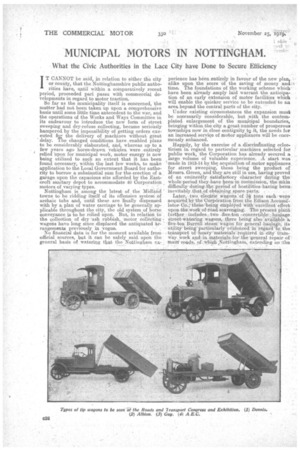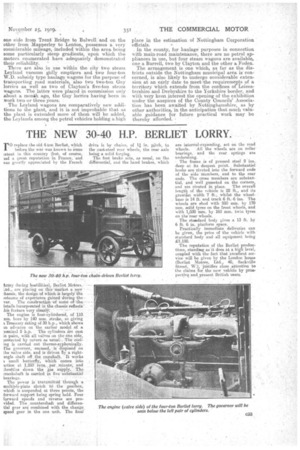MUNICIPAL MOTORS IN NOTTINGHAM.
Page 24

Page 25

If you've noticed an error in this article please click here to report it so we can fix it.
What the Civic Authorities in the Lace City have Done to Secure Efficiency
IT CANNOT be said, in relation to either the city or county, that the Nottinghamshire public authorities have, u.ritil within a comparatively recent period, proceeded pan Passu with commercial developments in regard to motor traction. So far as the municipality itself is concerned, the matter had not been taken up upon a comprehensive basis until some little time antecedent to the war, and the operations of the Works and Ways Committee in its endeavour to introduce the new folrin of street sweeping and dry-refuse collecting, became serionSly hampered by the hnpossibility of getting orders executed for the delivery of machines without great delay. The changed conditions have . enabled plans to be considerably elaborated, and, whereas up to a few years ago horse-drawn vehicles Were entirely relied 'upon for municipal work, motor energy is now being utilized to such an extent that it has been found necessary, within the last few weeks, to make application to the Local Government Board for authority to borrow a substantial BUM for the erection of a garage upon the capacious site afforded by the Eastcroft sanitary depot to accommodate 40 Corporation motors of varying types. Nottingham is among the latest ofMidland towns to be ridding itself of its offensve system of archaic tubs and, until those are 'finally dispensed, with by a plan of water carriage to be generally applicable throughout the city, the old system. of horse conveyance is to be relied upon. But, in relation to' the eellection of dry 'ash rubbish, motor collecting wagons have long since displaced the antiquated arrangements previously in vogue.
No financial data is for the moment available from official sources, but it can be safely said uPen the general basis of watering that the Nottingham ex perienee has been entirely in favour of the new plan, alike upon the score of the saving of money and-i
time. The foundations of the working scheme which have been already amply laid warrant the anticip.a,a tion of an early extension of motor facilities which will enable the quicker service to be extended to aai area beyond the central parts of the city.
Under existing circumstances the expansion must be necessarily considerable, but with the contema plated enlargement of the municipal boundaries, bringing within the city a great number of prosperous towruships now in close contiguity te it, the needs for an increased service of motor appliances will he enormously enhanced. Happily, by the exercise of a diserirdlnating eclecticism in regard to particular machines selected for
public work, the Corporation has already secured a large volume of valuable experience. A start was 1.made in 1013-14 by the acquisition of motor appliances for street sweeping, these being the product of
Messrs. Green, and they are still in use, having proved of an eminently Satisfactory character during the whole period they have been inconimission, the main difficulty during the period of hostilities having been, inevitably that of obtaining spare parts.
Later, two electric wagons of 3i tens each were acquired hY the Corporation from the Edison AcciunitlatorCd.;-the'se'being employed with excellent effect
upon the .work of road scavenging. Tile present piAilti. I urther includes : two five ten convertible haulage
• Street-watering wagons, there being also available -a fiVe-ton. Burrell steam wagon for general haulage, its
utility-being particularly evidenced in regairto. the transport of heavy materials required in -City frail);
way work and in the -general 'repair of maid rojcIs, of which ;Natingham, extroi ding on the _ one side from Trent Bridge to Bul.well and on the other from Mapperley to -Lenten, possesses a very considerable mile-age, included within the area being some particularly steep, gradients, upon which the motors enumerated have ndequately demonstrated their reliability. — There are also in use within the city two steam Leyland vacuum g;ully emptiiers and two four-ton W.D. subsidy type haulage wagons for the purpose of transporting road materials, also two two-ton Guy lorries as well as two of Clayton's five-ton steam wagons. The latter were placed -in commission only about a nionth ago, the Guy lorries having been. in work two or three years: The Leyland wagons Are comparatively new additions to the plant, and it is not improbable that as the plant is extended more of them will be added, the Le.ylands among the petrel vehicles holding a high
place in the estimation of Nottingham Coxporation. officials.
. In the county, for haulage' purposes in connection with main-road maintenance, there are no petrol appliances in use, but four steam wagons are available, . one a Burrell, two by Clayton and the other a Foden. The arrangement is one which, as far as the districts outside the Nottingham municipal area is con-' cerned, is also likely to undergo considerable extension at an early date to: tneet4he requirements of a
territory which extends .from the confines Leioestershiro andDerbyshire to the Yorkshire border, and with very keen interest' the opening of the exhibition under the auspices of the County. Councils' Association has been awaited by Nottinghamshire, as by other authorities,rin the anticipation that much valuable guidance for future practical work may be thereby . afforded.








































